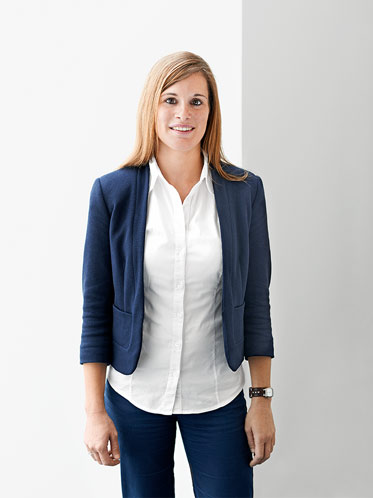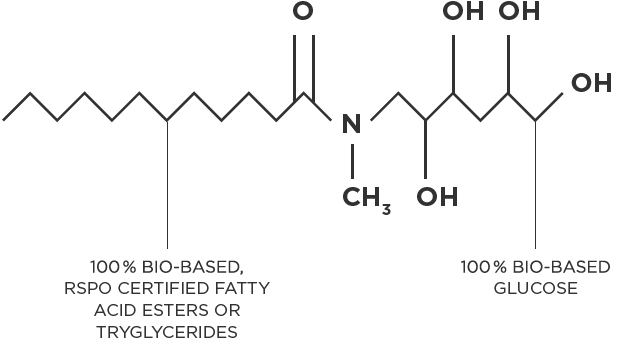GlucoPure is made of 95% biological raw materials. This results in an extremely powerful, almost 100% renewable surfactant
Innovative agents made from sustainable raw materials
The glucamides produced from renewable raw materials have a wide range of applications. In the field of dish washing, they are responsible for long-lasting foam and superior cleaning performance. This means less detergent with the same performance. It is also gentle on the hands. But their main advantage is that they have an excellent environmental profile in addition to their special performance.

GLUCAMIDES
Excellent performance together with environmental compatibility
Palm oil is – besides its most frequent use in food industry – a raw material that can be used, for example, in the manufacture of surfactants, which help in cleaning. A surfactant consists of a water-friendly and a water-repellent area. The water-repellent area binds with the dirt particles while the water-friendly area binds with the water used for cleaning. As a result, the particles detach from the surfaces to be cleaned much more easily.
Conventional (petrochemical) surfactants are made from crude oil and are electrically charged. An alternative are sugar-based surfactants produced from vegetable fats. These surfactants are described as »non-ionic« because they have no electrical charge. Non-ionic surfactants have advantages: They can be made entirely from renewable raw materials instead of crude oil. Non-ionic surfactants are also gentler to the skin, non-toxic and readily biodegradable. Surfactants from Clariant made from renewable raw materials such as palm oil therefore contain neither aggressive sulfates nor polyethylene oxides. They are very mild and well tolerated by the skin.
Glucamides made from palm oil are surfactants, which are used as a raw material in a variety of specifications for the most diverse applications and products for body care and cosmetics. Modern surfactants should have an excellent environmental profile, a high proportion of renewable raw materials, in addition to very good product properties. They should also be cost-effective. The glucamides are novel sugar-based surfactants, which are made of up to 95% renewable raw materials and a high percentage of non-tropical biomass. The products are also readily biodegradable. Glucamides do not contain sulfates or ethylene oxide (EO), which is suspected of causing allergic skin reactions.
A key success factor in this innovation was the interaction between the various disciplines within Clariant. This development was only possible due to the intensive exchange between experts in the fields of cosmetics, detergents, crop protection and oil production along with colleagues in application technology and research.

»With our innovative co-surfactants GlucoPure the perfect balance between ecology and performance is achieved.«
Are there any dishwashing liquids on the market that are 100% green?
Christine Müller To the best of our knowledge, no. Even the vast majority of green brands contain a certain percentage of petroleum-based ingredients.
Why then do some green dishwashing liquids print »from renewable resources« on their bottles?
Christine Müller Generally, those claims are quite correct, and such products actually all contain natural-based ingredients. But there is no law stating how large the percentage of the »green« share must be in order to make such a claim.
Could you put into layman’s terms where these essential »non-green« parts are found?
Christine Müller Dishwashing liquids are usually composed of at least two types of surfactants: a primary surfactant, consisting of an anionic head group and a hydrophobic tail, and a secondary, or co-surfactant. The most commonly used primary surfactant is sodium lauryl ether sulfate (SLES). In green products, the hydrophobic part of all surfactants is usually based on biological resources, but the hydrophilic head groups are still mostly synthetically prepared.
And what about the co-surfactants?
Christine Müller Some market products contain the highest possible amount of green surfactants. However, these dishwashing liquids perform poorly in tests compared to their standard counterparts. The co-surfactant that we developed at Clariant is made from 95% bio-based materials, with the remaining 5% containing a petroleum-based molecular structure. The result is an incredibly powerful, nearly 100% green surfactant. With this innovative co-surfactant, the perfect balance between ecology and performance is achieved. We call it GlucoPure, as it is sugar, or glucose, based.
Can’t we just stop using petroleum entirely?
Christine Müller Unfortunately, the small petroleum-based part is an essential structural element of our co-surfactant. At present, this cannot be produced using natural-based raw materials, and our researchers have not yet found an adequate alternative.
How has GlucoPure fared in tests?
Christine Müller It is twice as effective as the current market-leading, completely green co-surfactant and achieves comparative results to conventional surfactants like cocamidopropyl betaine or amine oxides. But we are not about to rest on our laurels!


GlucoPure
ECOTAIN® APPROVED
GlucoPure fulfills the criteria of EcoTain®, our approach to sustainability on product level.
DISCOVER VALUE – GLUCOPURE